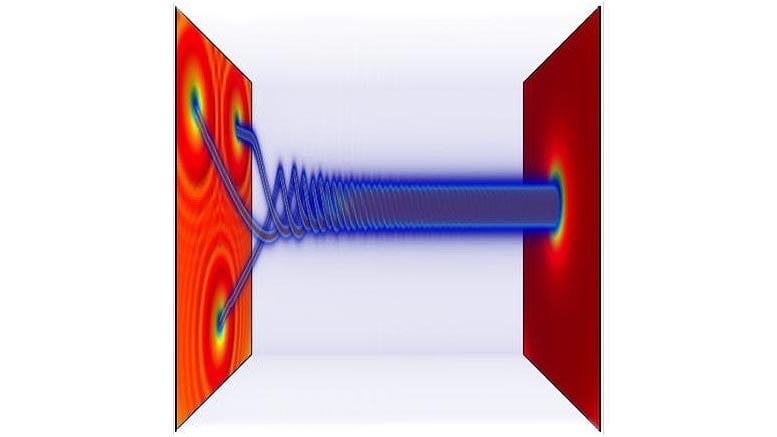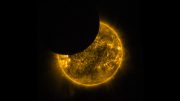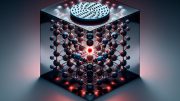New mechanism found for generating giant vortices in quantum fluids of light.
Anyone who has drained a bathtub or stirred cream into coffee has seen a vortex, a ubiquitous formation that appears when fluid circulates. But unlike water, fluids governed by the strange rules of quantum mechanics have a special restriction: as was first predicted in 1945 by future Nobel winner Lars Onsager, a vortex in a quantum fluid can only twist by whole-number units.
These rotating structures are predicted to be widely useful for studying everything from quantum systems to black holes. But while the smallest possible quantum vortex, with a single unit of rotation, has been seen in many systems, larger vortices are not stable. While scientists have attempted to force larger vortices to hold themselves together, the results have been mixed: when the vortices have been formed, the severity of the methods used have generally destroyed their usefulness.
Now, Samuel Alperin and Professor Natalia Berloff from the University of Cambridge have discovered a theoretical mechanism through which giant quantum vortices are not only stable but form by themselves in otherwise near-uniform fluids. The findings, published in the journal Optica, could pave the way for experiments that might provide insight into the nature of rotating black holes that have similarities with giant quantum vortices.
To do this, the researchers used a quantum hybrid of light and matter, called a polariton. These particles are formed by shining laser light onto specially layered materials. “When the light gets trapped in the layers, the light and the matter become inseparable, and it becomes more practical to look at the resulting substance as something that is distinct from either light or matter, while inheriting properties of both,” said Alperin, a PhD student at Cambridge’s Department of Applied Mathematics and Theoretical Physics.
One of the most significant properties of polaritons comes from the simple fact that light can’t be trapped forever. A fluid of polaritons, which requires a high density of the exotic particles, is constantly expelling light, and needs to be fed with fresh light from the laser to survive. “The result,” said Alperin, “is a fluid which is never allowed to settle, and which doesn’t need to obey what are usually basic restrictions in physics, like the conservation of energy. Here the energy can change as a part of the dynamics of the fluid.”
It was exactly these constant flows of liquid light that the researchers exploited to allow the elusive giant vortex to form. Instead of shining the laser on the polariton fluid itself, the new proposal has the light shaped like a ring, causing a constant inward flow similar to how water flows to a bathtub drain. According to the theory, this flow is enough to concentrate any rotation into a single giant vortex.
“That the giant vortex really can exist under conditions that are amenable to their study and technical use was quite surprising,” Alperin said, “but really it just goes to show how utterly distinct the hydrodynamics of polaritons are from more well-studied quantum fluids. It’s exciting territory.”
The researchers say that they are just at the beginning of their work on giant quantum vortices. They were able to simulate the collision of several quantum vortices as they danced around each other with ever increasing speed until they collided to form a single giant vortex analogous to the collision of black holes. They also explained the instabilities that limit the maximum vortex size while exploring the intricate physics of the vortex behavior.
“These structures have some interesting acoustic properties: they have acoustic resonances that depend on their rotation, so they sort of sing information about themselves,” said Alperin. “Mathematically, it’s quite analogous to the way that rotating black holes radiate information about their own properties.”
The researchers hope that the similarity could lead to new insights into the theory of quantum fluid dynamics, but they also say that polaritons might be a useful tool to study the behavior of black holes.
Reference: “Multiply charged vortex states of polariton condensates” by Samuel N. Alperin and Natalia G. Berloff, 1 March 2021, Optica.
DOI: 10.1364/OPTICA.418377
Professor Berloff is jointly affiliated with Cambridge and the Skolkovo Institute of Science and Technology in Russia.










AT LAST! An interpretation of what IS being observed rather than a speculation on what we might!
It was exactly these constant flows of liquid light that the researchers exploited to allow the elusive giant vortex to form.
Instead of shining the laser on the polariton fluid itself, the new proposal has the light shaped like a ring, causing a constant inward flow similarly to how water flows to a bathtub drain.
According to the theory, this flow is enough to concentrate any rotation into a single giant vortex.
It was exactly these constant flows of liquid light that the sun exploited to allow the elusive giant vortex to form.
Instead of shining the light on the polariton fluid itself,
the suns proposal has the light shaped like a ring, causing a constant inward flow similarly to how water flows to a bathtub drain. except it goes to earths liquid iron core
According to the sun, this flow is enough to concentrate any rotation into a single giant vortex. inside the core
what would happen then sun
] And all of this means… what? I have beem impressed with the ability of quantum physics to create advanced technology (such as MRI’s and quantum computers). And the study of it has indeed pushed the philosophy of science to its limits, revealing how mystetious the universe still is.
But one must ask… is all of this going anywhere. Many millions of dollars are being spent every year. “Large vortices”, “liquid light”, “polaritons”?? It’s starting to sound more like an episode of Harry Potter than like a piece of potentially useful applied science. Sooner or later, it has to make some kind of practical sense. The more it costs, the sooner that should be.
I don’t think there needs to be an obvious payoff for science. The more we contribute to our knowledge base, the more we can build off of it and do more and more interesting things. That may eventually lead to a practical application eventually or it may not. There is no way of knowing whether or not any pursuit will be useful ahead of time.
Have to I have to agree with what bill says, what is the practical application of these Gene Roddenberry esque names for s*** that isn’t going to make any people less hungry or homeless.
Sounds exactly like a wormhole formation,albeita baby one.